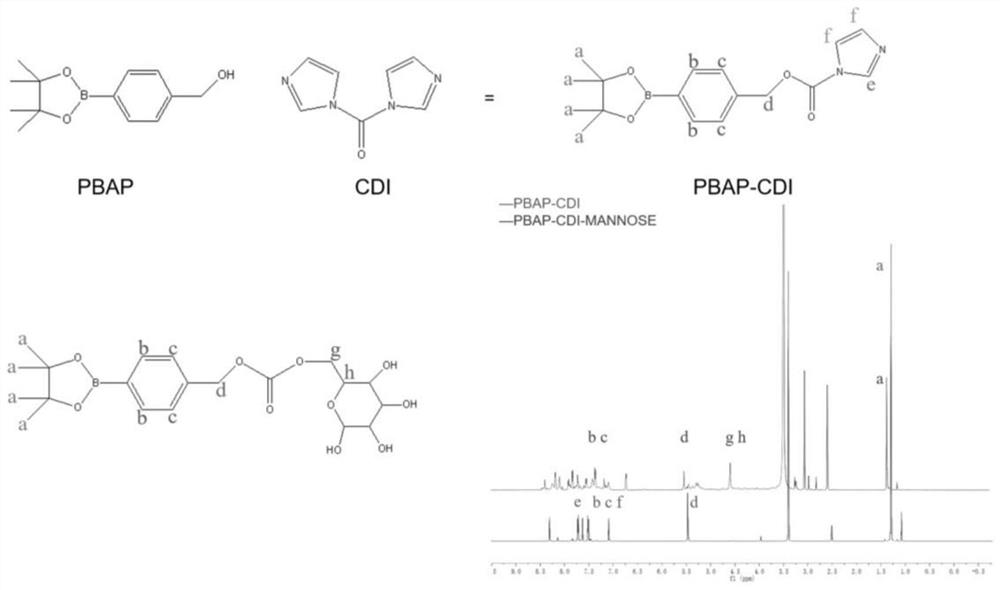Nano-drug for inhibiting injured vascular intimal hyperplasia and application of nano-drug
A biomimetic nanometer and nanoparticle technology, applied in the field of biomedicine, can solve the problems of poor targeting and immune evasion ROS response, and achieve the effects of strong targeting, solubilization and uniform particle size.
- Summary
- Abstract
- Description
- Claims
- Application Information
AI Technical Summary
Problems solved by technology
Method used
Image
Examples
Embodiment 1
[0045]Example 1 Synthesis route and principle of carrier PBAP-CDI-Mannose (PCM)
[0046]
[0047] The -OH on PBAP can react with the imidazole structure on CDI to form a lipid bond, by controlling the feed ratio during the synthesis. The combination number of imidazole structure on CDI and PBAP can be controlled. The PBAP-CDI synthesized in this experiment retained an imidazole structure for the next step of combining with mannose. Mannose is a six-carbon sugar with good hydrophilicity. Similarly, the -OH on it can react with the imidazole structure to form a lipid bond. In the experiment, stir overnight at 40°C and add the catalyst 4-dimethylaminopyridine (4-dimethylaminopyridine, DMAP) to ensure the full combination of PBAP-CDI and mannose. Since the PBAP part exhibits hydrophobic properties and the mannose part exhibits hydrophilic properties, the carrier PCM has amphiphilicity, and nanocarriers can be prepared by nanoprecipitation.
[0048] Here are the specific step...
Embodiment 2
[0052] Example 2 Preparation method of biomimetic nanoparticles MM@PMR
[0053] The preparation method of biomimetic nanoparticles MM@PMR, the preparation process is as follows,
[0054] (1) Utilize the PCM and RAPA dissolution dialysis that obtains in the embodiment 1 to obtain described PMR nanoparticle;
[0055] (2) extract macrophage cell membrane;
[0056] (3) Coating the PMR nanoparticles with the macrophage membrane to prepare biomimetic nanoparticles MM@PMR.
[0057] Specifically, the mass ratio of PCM to RAPA is 10:1.
[0058] Specifically, in step (3), a liposome extruder with a pore size of 200 nm is used to blend and extrude the macrophage membrane and the PMR nanoparticles to prepare raw nanoparticles MM@PMR.
[0059] The specific implementation process is listed here:
[0060] (1) Synthesis of PMR loaded with RAPA nanoparticles
[0061] 10 mg of the carrier PCM prepared in Example 1 and 1 mg of RAPA were fully dissolved in 200 μL of DMF, and the above organi...
Embodiment 3
[0071] Example 3 Characterization analysis of bionic particles
[0072] 1. Characterization analysis of particle size, potential and TEM morphology of the prepared PMR and MM@PMR
[0073] The hydration size and potential of the prepared PMR, MM@PMR nanoparticles and macrophage membrane microcapsules (MM) were measured at room temperature by a Malvern laser particle size analyzer, and the results were as follows figure 2 As shown, wherein, the particle diameter of PMR is 109.4nm, and PDI is 0.123, shows that the experiment successfully synthesized the PMR nanoparticle with hydrated particle diameter of about 100nm and the size uniformity of nanoparticle is good, and the size of nanoparticle is concentrated normal distributed. MM@PMR is prepared by co-extruding PMR nanoparticles and macrophage membrane microcapsules. When passing through a nanopore with a certain pore size, physical extrusion will make the flexible lipid microcapsules coat the PMR nanocapsules. On the particl...
PUM
| Property | Measurement | Unit |
|---|---|---|
| Particle size | aaaaa | aaaaa |
| Particle size | aaaaa | aaaaa |
| Size | aaaaa | aaaaa |
Abstract
Description
Claims
Application Information
 Login to View More
Login to View More - R&D
- Intellectual Property
- Life Sciences
- Materials
- Tech Scout
- Unparalleled Data Quality
- Higher Quality Content
- 60% Fewer Hallucinations
Browse by: Latest US Patents, China's latest patents, Technical Efficacy Thesaurus, Application Domain, Technology Topic, Popular Technical Reports.
© 2025 PatSnap. All rights reserved.Legal|Privacy policy|Modern Slavery Act Transparency Statement|Sitemap|About US| Contact US: help@patsnap.com



